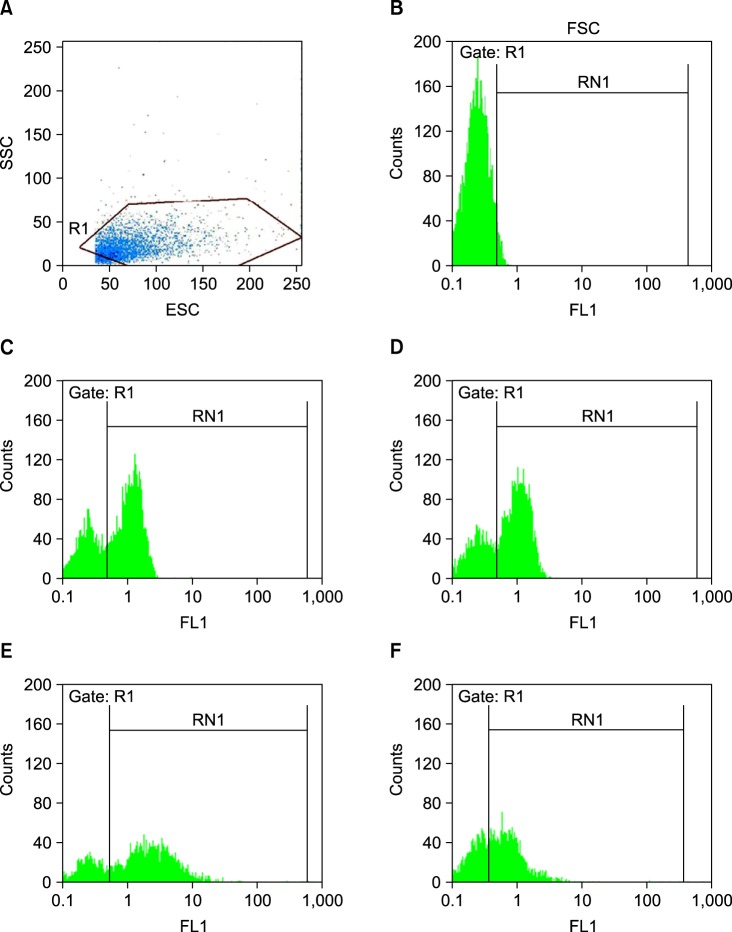Blood Res.
2014 Mar;49(1):49-53. 10.5045/br.2014.49.1.49.
The caspase-3 inhibitor (peptide Z-DEVD-FMK) affects the survival and function of platelets in platelet concentrate during storage
- Affiliations
-
- 1Blood Transfusion Research Center, High Institute for Research and Education in Transfusion Medicine, Tehran, Iran. f.yari@ibto.ir
- 2Ilam University of Medical Sciences, Ilam, Iran.
- KMID: 2172823
- DOI: http://doi.org/10.5045/br.2014.49.1.49
Abstract
- BACKGROUND
Although apoptosis occurs in nucleated cells, studies show that this event also occurs in some anucleated cells such as platelets. During storage of platelets, the viability of platelets decreased, storage lesions were observed, and cells underwent apoptosis. We investigated the effects of caspase-3 inhibitor on the survival and function of platelets after different periods of storage.
METHODS
Platelet concentrates were obtained from the Iranian Blood Transfusion Organization in plastic blood bags. Caspase-3 inhibitor (Z-DEVD-FMK) was added to the bags. These bags along with control bags to which no inhibitor was added were stored in a shaking incubator at 22degrees C for 7 days. The effects of Z-DEVD-FMK on the functionality of platelets were analyzed by assessing their ability to bind to von Willebrand factor (vWF) and to aggregate in the presence of arachidonic acid and ristocetin. Cell survival was surveyed by MTT assay.
RESULTS
At day 4 of storage, ristocetin-induced platelet aggregation was significantly higher in the inhibitor-treated (test) than in control samples; the difference was not significant at day 7. There was no significant difference in arachidonic acid-induced platelet aggregation between test and control samples. However, at day 7 of storage, the binding of platelets to vWF was significantly higher in test than in control samples. The MTT assay revealed significantly higher viability in test than in control samples at both days of study.
CONCLUSION
Treatment of platelets with caspase-3 inhibitor could increase their functionality and survival.
MeSH Terms
Figure
Reference
-
1. Stellos K, Kopf S, Paul A, et al. Platelets in regeneration. Semin Thromb Hemost. 2010; 36:175–184. PMID: 20414833.
Article2. Spiess BD. Platelet transfusions: the science behind safety, risks and appropriate applications. Best Pract Res Clin Anaesthesiol. 2010; 24:65–83. PMID: 20402171.
Article3. White GC 2nd. Congenital and acquired platelet disorders: current dilemmas and treatment strategies. Semin Hematol. 2006; 43(1):Suppl 1. S37–S41. PMID: 16427384.
Article4. Thon JN, Schubert P, Devine DV. Platelet storage lesion: a new understanding from a proteomic perspective. Transfus Med Rev. 2008; 22:268–279. PMID: 18848154.
Article5. Shrivastava M. The platelet storage lesion. Transfus Apher Sci. 2009; 41:105–113. PMID: 19683964.
Article6. Salvesen GS, Dixit VM. Caspases: intracellular signaling by proteolysis. Cell. 1997; 91:443–446. PMID: 9390553.
Article7. Kothakota S, Azuma T, Reinhard C, et al. Caspase-3-generated fragment of gelsolin: effector of morphological change in apoptosis. Science. 1997; 278:294–298. PMID: 9323209.
Article8. Weil M, Jacobson MD, Raff MC. Are caspases involved in the death of cells with a transcriptionally inactive nucleus? Sperm and chicken erythrocytes. J Cell Sci. 1998; 111:2707–2715. PMID: 9718364.
Article9. Li J, Xia Y, Bertino AM, Coburn JP, Kuter DJ. The mechanism of apoptosis in human platelets during storage. Transfusion. 2000; 40:1320–1329. PMID: 11099659.
Article10. Ohto H, Nollet KE. Overview on platelet preservation: better controls over storage lesion. Transfus Apher Sci. 2011; 44:321–325. PMID: 21507724.
Article11. Jackson SP, Schoenwaelder SM. Procoagulant platelets: are they necrotic? Blood. 2010; 116:2011–2018. PMID: 20538794.
Article12. Seghatchian J, Krailadsiri P. Platelet storage lesion and apoptosis: are they related? Transfus Apher Sci. 2001; 24:103–105. PMID: 11515605.
Article13. Seghatchiana J, de Sousa G. Blood cell apoptosis/necrosis: some clinical and laboratory aspects. Ann N Y Acad Sci. 2003; 1010:540–547. PMID: 15033787.
Article14. van der Meer PF, de Korte D. Platelet preservation: agitation and containers. Transfus Apher Sci. 2011; 44:297–304. PMID: 21514232.
Article15. Kuter DJ. Apoptosis in platelets during ex vivo storage. Vox Sang. 2002; 83(Suppl 1):311–313. PMID: 12617160.
Article16. Piguet PF, Vesin C. Modulation of platelet caspases and life-span by anti-platelet antibodies in mice. Eur J Haematol. 2002; 68:253–261. PMID: 12144531.
Article17. Cohen Z, Wilson J, Ritter L, McDonagh P. Caspase inhibition decreases both platelet phosphatidylserine exposure and aggregation: caspase inhibition of platelets. Thromb Res. 2004; 113:387–393. PMID: 15226093.18. Doggett TA, Girdhar G, Lawshe A, et al. Selectin-like kinetics and biomechanics promote rapid platelet adhesion in flow: the GPIb(alpha)-vWF tether bond. Biophys J. 2002; 83:194–205. PMID: 12080112.19. Kang M, Wilson L, Kermode JC. Evidence from limited proteolysis of a ristocetin-induced conformational change in human von Willebrand factor that promotes its binding to platelet glycoprotein Ib-IX-V. Blood Cells Mol Dis. 2008; 40:433–443. PMID: 17977030.
Article20. Mody NA, King MR. Platelet adhesive dynamics. Part II: high shear-induced transient aggregation via GPIbalpha-vWF-GPIbalpha bridging. Biophys J. 2008; 95:2556–2574. PMID: 18515386.21. Vanhee D, Joseph M, Vorng H, Tonnel AB. A colorimetric assay to evaluate the immune reactivity of blood platelets based on the reduction of a tetrazolium salt. J Immunol Methods. 1993; 159:253–259. PMID: 8445256.
- Full Text Links
- Actions
-
Cited
- CITED
-
- Close
- Share
- Similar articles
-
- Evaluation of Platelet Concentrates Stored in the Second Generation Platelet Storage Containers
- Factors Affecting pH Changes in Preserving Platelet Concentrates
- Effects and treatment applications of polymeric nanoparticles on improving plateletsÊ storage time: a review of the literature from 2010 to 2020
- Ceramide-Induced Apoptosis in Cultured Keratocyte
- Activation of caspase-8 in 3-deazaadenosine-induced apoptosis of U-937 cells occurs downstream of caspase-3 and caspase-9 without Fas receptor-ligand interaction


